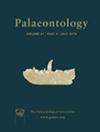Taxic and morphological diversification during the early radiation of Clupeomorpha (Actinopterygii, Teleostei)
IF 2.3
2区 地球科学
Q1 PALEONTOLOGY
引用次数: 0
Abstract
Abstract Evolutionary radiation is a problematic concept whose definition and classification have recently changed. Radiations can be defined as the pattern of abrupt increase in diversity of a lineage. It is relevant to evaluate the presence and interaction of different types of radiation in extant and fossil organisms to adequately delimitate the radiation types and to know the diversity in the context of Earth's history. Here, we employed the superorder Clupeomorpha at the Early–Late Cretaceous boundary as a study case to investigate radiation types and their interactions, using both taxic and morphological approaches. Clupeomorpha is an extensively studied, diverse and ancient teleostean superorder with wide geographical and ecological distributions. We propose a model for calculating rates of origination in order to analyse the taxic diversification and employ geometric morphometrics to analyse the morphological diversification that occurred at the temporal boundary. The results suggest the absence of taxic radiation due to a constant increase in taxon origination. However, the expansion of the phylomorphospace occupation and the disparity increase suggest the presence of a ‘climatic–geographical’ or ‘broad diversification‐like’ disparity, according to current classifications. This illustrates the incompatibility of current radiation classifications with this case study.放线鸟属(Actinopterygii, Teleostei)辐射早期的分类和形态变化
进化辐射是一个有问题的概念,其定义和分类最近发生了变化。辐射可以定义为一个谱系的多样性突然增加的模式。评估现存和化石生物中不同类型的辐射的存在和相互作用,对充分界定辐射类型和了解地球历史背景下的辐射多样性具有重要意义。本文以早-晚白垩世边界的超目Clupeomorpha为研究对象,利用分类和形态学方法研究了辐射类型及其相互作用。棒形目是一种研究广泛、种类多样的古老远骨目,具有广泛的地理和生态分布。我们提出了一个计算起源率的模型来分析分类多样化,并采用几何形态计量学来分析发生在时间边界的形态多样化。结果表明,由于分类群起源的不断增加,分类辐射的缺失。然而,根据目前的分类,层形态空间占用的扩大和差异的增加表明存在“气候-地理”或“广泛多样化-类”差异。这说明了当前辐射分类与本案例研究的不兼容性。
本文章由计算机程序翻译,如有差异,请以英文原文为准。
求助全文
约1分钟内获得全文
求助全文
来源期刊

Palaeontology
地学-古生物学
CiteScore
5.60
自引率
3.80%
发文量
43
审稿时长
6 months
期刊介绍:
Palaeontology publishes a wide variety of papers on palaeontological topics covering:
palaeozoology
palaeobotany
systematic studies
palaeoecology
micropalaeontology
palaeobiogeography
functional morphology
stratigraphy
taxonomy
taphonomy
palaeoenvironmental reconstruction
palaeoclimate analysis and biomineralization studies.
 求助内容:
求助内容: 应助结果提醒方式:
应助结果提醒方式:


